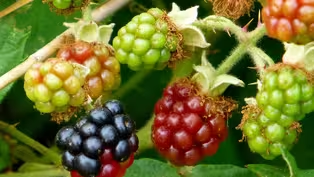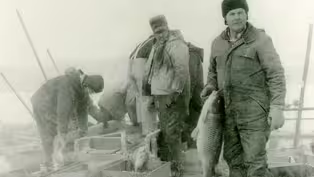Prairie Sportsman
Keep It Clean
Clip: Season 16 Episode 10 | 12m 34sVideo has Closed Captions
Host Bret Amundson visits the “Keep it Clean” project in progress on Lake Mille Lacs.
Host Bret Amundson visits Garrison, Minnesota to talk about the “Keep it Clean” project going on at Lake Mille Lacs. Ann Brucciani Lyon is a member of the Keep it Clean coalition. She consulted with chorts at Lake of the Woods and business owners around Mille Lacs who have participated in grass roots efforts to clean up the trash left on the ice.
Problems playing video? | Closed Captioning Feedback
Problems playing video? | Closed Captioning Feedback
Prairie Sportsman is a local public television program presented by Pioneer PBS
Production sponsorship is provided by funding from the Environment and Natural Resources Trust Fund, West Central Initiative, Shalom Hill Farm, and members of Pioneer PBS.
Prairie Sportsman
Keep It Clean
Clip: Season 16 Episode 10 | 12m 34sVideo has Closed Captions
Host Bret Amundson visits Garrison, Minnesota to talk about the “Keep it Clean” project going on at Lake Mille Lacs. Ann Brucciani Lyon is a member of the Keep it Clean coalition. She consulted with chorts at Lake of the Woods and business owners around Mille Lacs who have participated in grass roots efforts to clean up the trash left on the ice.
Problems playing video? | Closed Captioning Feedback
How to Watch Prairie Sportsman
Prairie Sportsman is available to stream on pbs.org and the free PBS App, available on iPhone, Apple TV, Android TV, Android smartphones, Amazon Fire TV, Amazon Fire Tablet, Roku, Samsung Smart TV, and Vizio.

Prairie Sportsman Premium Gifts
Do you love the great outdoors, hunting, fishing, hiking and conservation? Consider becoming a friend of Prairie Sportsman to support it and receive gifts with your contribution.Providing Support for PBS.org
Learn Moreabout PBS online sponsorship(upbeat music) - We're here in Garrison, Minnesota as the ice fishing season wraps up on legendary Mille Lacs Lake.
Now one quick little look around this area and you'll see a lot of trash that's accumulated over the winter months.
Well there's a big movement that's come to the area in recent years to help Keep It Clean.
(upbeat music) In recent years, anglers are spending more time on the ice, wheelhouses, float suits, and other ways to say warmer longer has allowed people to fish more.
This creates the potential for more trash being left on lakes.
After a few years of seeing this, it was clear something needed to be done.
Lake of the Woods tourism, the Minnesota DNR, Lake of the Woods Soil and Water District, Lake of the Woods County, and the friends of Zippel Bay State Park formed a committee that created the Keep It Clean campaign.
- It's now illegal to place any kind of trash, waste, human waste, any kind of garbage on the ice.
What you need to do now is you need to plan ahead.
You gotta keep it in your fish house, you keep it in your vehicle, or you keep it in an enclosed container, but we don't put it on the ice anymore.
And really what that's gonna do is it's just by happenstance, it's gonna keep tons of garbage off in Minnesota waterways.
- [Bret] The Keep It Clean movement continued across the state going to Upper Red Lake and then Mille Lacs.
- And so initially we thought maybe what we'd do is a spring cleanup day of some sort, organize, try to get participation and community engagement.
And I offered to do some research and went down the internet rabbit hole and very quickly found Joe Henry and Mike Hurst up at Lake of the Woods and said, "Hey, I understand you've got a program up there to address garbage on the ice.
Why don't we team up?"
We've heard from Upper Red Lake recently and we can have three of the largest walleye fisheries in the state working together.
I consulted with Eddy Lyback and a few other business owners around the lake and they said, "Yeah, do it.
We've got a problem and we need a solution."
- [Bret] While the Keep It Clean effort is relatively new.
Cleanup around Mille Lacs has been going on for years.
- I'd say 1982, '83, you know, we started things just a lot of resorts had their own way of picking up their trash.
We had what we used to call block parties, which at the end of the year customers would come up and a whole crew of people would go out in the lake, pick up whatever was out there as far as trash, plastic bags, fish house blocks that got missed, whatever they could see.
It evolved into a lake wide event for almost 10 years.
But it was hard to organize it because of the timing of the year when you had to be out there.
Then along when Ann came with this Keep It Clean idea, momentum picked up again.
- [Bret] Cleanup crews have found all sorts of trash.
- Some type of plastic, sometimes styrofoam things that get missed or blown or covered up with the snow.
- [Bret] While trash blown up along the shorelines has been a problem, what may be the biggest issue is anglers leaving behind human waste.
- Plan ahead, right?
Have your garbage bags know where you're gonna go to the bathroom and know where gonna bring your trash when you go off the ice.
- You know, not everybody's gonna be able to dump stuff.
So there's human waste and plastic bags, where's it gonna go?
Is there gonna be separate dumpsters for that or is it, because it's winter and frozen, included in the trash dumpster and ends up in the landfill?
- As a Keep It Clean effort grew here at Mille Lacs and even expanded out into the region, Ann was looking for new ways to keep Mille Lacs clean.
And she heard about a crew that had a special project out at Lake Tahoe.
(exciting music) - I kinda think in phases and one of the thoughts was, if we stop, if we stop the trash from going into the ice or help mitigate the amount that's going into the ice, what do we do about the garbage that's already in the lake?
What kind of impact does that have?
And specifically, what happens to garbage once it enters Mille Lacs?
Where, if anywhere, does it go?
So I had remembered reading about somebody, Colin West, who led a huge initiative with up to 300 volunteers scuba divers on a year long mission to go in and pull all the trash outta Lake Tahoe.
- Yeah, Tahoe was really, like I, you know, I was doing a beach cleanup one day and we pulled 40 pounds of trash from a beach where there were thousands of people present, you know, and felt good and was like, "Yay, that's nice."
But in fact, that same very day, a good friend of mine from where I grew up was hosting a scuba cleanup in a tiny, pristine looking, beautiful cove where if you're on your boat the it would just look like you're in the Caribbean.
Gorgeous granite rocks though might throw you off, but the waters are are gorgeous and you just don't see any issues.
But when you dive underneath it, it was trashed.
And they pulled out over 600 pounds of small litter items and we're talking about 600 pounds of things like aluminum cans and plastic and, like, clothing.
It's not like four chunks of metal.
- [Bret] After having a discussion with Ann, the two agreed on a pilot project where the group would come out and dive in Mille Lacs, but based on the landscape, the approach would have to be different than it was at Tahoe.
- The litter accumulation and distribution in that lake is very different than in Alpine lakes because in Alpine lakes, if you have these sheer walls that come down, you know, and you have stuff dropping in and wind blowing it, it kind of and it hits those walls and collects there.
- [Bret] After observing some blue-green algae, the crew employed a remote operated vehicle to search the floor of Mille Lacs.
After test results revealed just trace amounts of cyanobacteria that would be safe for divers.
The crew jumped in the lake.
- You know, we got there, and for our team, it was a completely different experience than diving Alpine lakes.
We could at least see the very significant amount of muscles and invasive species that were there, which I know is an issue that Mille Lac struggles with.
- And so a lot of the heavy litter items were really difficult to identify because they were so covered with zebra muscles, but they found cinder blocks, they found glass bottles, they found a Buick hubcap.
(somber music) - [Bret] Despite sifting through the muscles to find some of these large items, they didn't find as many as they thought they would.
- I was ready to pack huge lift bags and thinking we were gonna stack 15,000 pounds of litter or more in two weeks from what I heard.
But I think ultimately we only found a couple hundred pounds, and I think there's a few factor that could play into that.
- The trash that was gathered was sorted at these litter sorting events and put into one of 83 maritime categories and then weighed and documented.
- [Bret] Tracking what kind of litter it is and where they find it on the lake will help them track down where it's coming from.
- So that can help you better understand, is it construction debris?
Is it people drinking and partying and playing with their dogs?
Is that fishing equipment, et cetera.
So we can actually see, you know, the source of that litter.
And so that's kind of where everything goes is through that analysis process.
- So one of the conclusions clean up the lake came to was that the heavyweight litter seems to drop and kind of stay where it's at and often gets covered by zebra muscles.
The mid-weight litter is likely on the move.
We didn't find as many cell phones as we know are lost down there.
So those items probably are covered and uncovered and covered and uncovered.
- I think what we found over, you know, two weeks of working and diving out there is that a lot of the litter was more than likely actually blowing up onto shore.
So those beach cleanups that local communities were doing and local volunteers were actually recovering a lot of the litter that was making its way into the lake.
- [Bret] Cleaning up the lake is not only good for the environment, it helps you learn a little bit about the area's past.
What's the story behind the anchor?
- Well, back in the early zebra mussel years, we had one spring where we didn't have much of wind activity when the lake went off and the water was extremely clear.
Some of my daughter's friends were out running around on Wahkon Bay just looking at what all the stuff they could see and they found about this much of that anchor sticking out of the mud on a little small reef southeast of or southwest of Otto's Point.
I had contacted Joe Fellegy, who was a Mille Lacs historian, had him come and look at it, and he immediately dug through a lot of his old pictures.
And we pretty much determined because of the age of the anchor, and you can tell by the style of steel and how it's sort of stringy like this and rusting, that it obviously was very old.
More than likely, was an anchor on one of the lake steamers in Mille Lacs Lake.
There was a company back in the mid 1800s called the Mille Lacs Lake Steamship Company.
On every one of those boats was an anchor like that hanging off the bow.
(gentle music) - [Bret] Even though efforts to clean up have improved, there was still a need to create new legislation.
- If you've ice fish in Minnesota, you realize that the new law, right?
Last year we had with new law started, it's a great law.
- We looked at the language over litter in the lake during summer on open water and realized there wasn't anything comparable to frozen water.
So we drafted a bill that got picked up by Representative Andrew Meyers.
It was introduced during the January 2023 legislative session, signed into law in May by partisan support.
The law took effect July 1st, 2023, making it illegal to place garbage and waste on or under the ice on all of Minnesota's lakes and rivers.
- Being we have a rental business and rental fish houses, you know, we have service workers that go out, collect garbage bags, toilet bags, et cetera, provide more, pick up whatever they got, haul it in.
And in the past we used to have them set that toilet bag on the ice so it would freeze or in a snow bank next to the house.
And with the new laws to make it easier and prevent that, we hung galvanized garbage cans on the side of the house, built brackets and had them elevated off the ice and lined them, you know, with another liner and had them put them in there.
So everything was in one spot.
- [Bret] Everyone we spoke to agreed that these efforts are making a difference.
So what does the future hold for Keep It Clean at Mille Lacs?
- Yeah, we've got some more plans in the works and I think they'll lead to greater community engagement and even wider understanding on what's happening to garbage in the lake, what people are finding, and some things that they can do to help increase the health of the lake by small individual contributions.
- [Bret] Colin will have more from his Mille Lacs pilot research project at cleanupthelake.org, and the Mille Lacs trash tracker pilot program was recently funded, and its goal is to reduce the amount of trash and also track the trash and identify where it's coming from to stop the littering at its source.
This will also allow more users of the lake to feel as though they're making a difference in keeping it clean.
- It's not a good look for any lake and it's not good for tourism.
And these businesses work so hard to provide an ideal experience for the visitors on the lake.
It's up to everybody to do their part, to support those businesses in addition to the environment and the overall effects on the l (gentle music fades)
Fast Forage: Black Raspberries
Video has Closed Captions
Clip: S16 Ep10 | 2m 49s | Fast Forager Nicole Zempel shows viewers how to find the delicious black raspberries in the wild. (2m 49s)
Piechowski Fishing and Protecting Water
Preview: S16 Ep10 | 30s | Host Bret Amundson visits Curt Piechowski on his family history in fishing and a new museum exhibit. (30s)
Video has Closed Captions
Clip: S16 Ep10 | 10m 13s | Bret visits Curt Piechowski at a new museum exhibit about his family history in fishing. (10m 13s)
Providing Support for PBS.org
Learn Moreabout PBS online sponsorship
- Science and Nature

Explore scientific discoveries on television's most acclaimed science documentary series.

- Science and Nature

Capturing the splendor of the natural world, from the African plains to the Antarctic ice.












Support for PBS provided by:
Prairie Sportsman is a local public television program presented by Pioneer PBS
Production sponsorship is provided by funding from the Environment and Natural Resources Trust Fund, West Central Initiative, Shalom Hill Farm, and members of Pioneer PBS.




